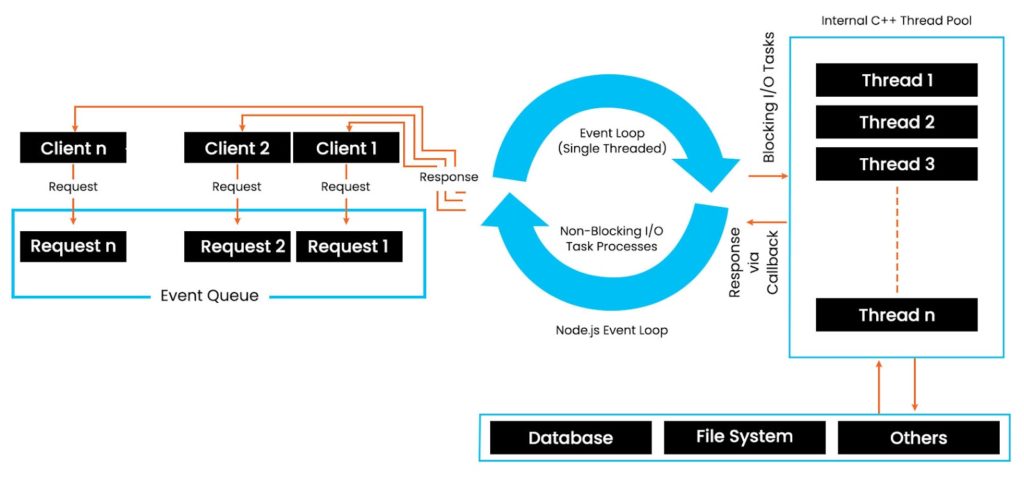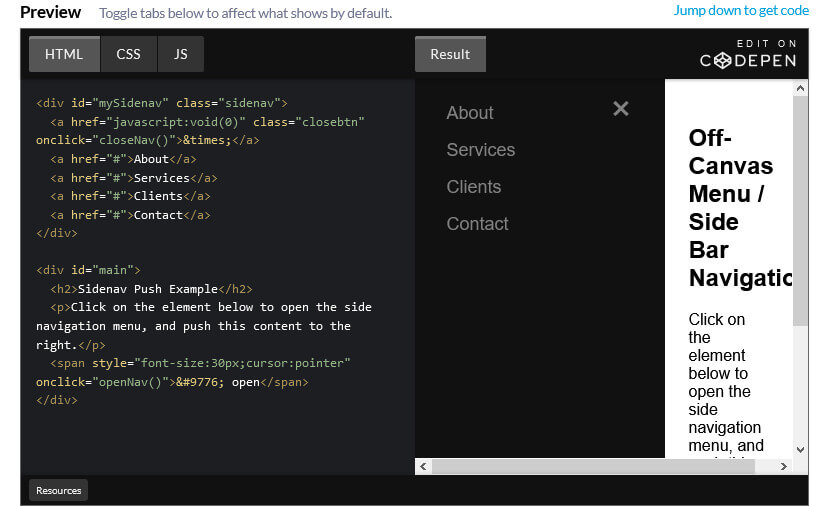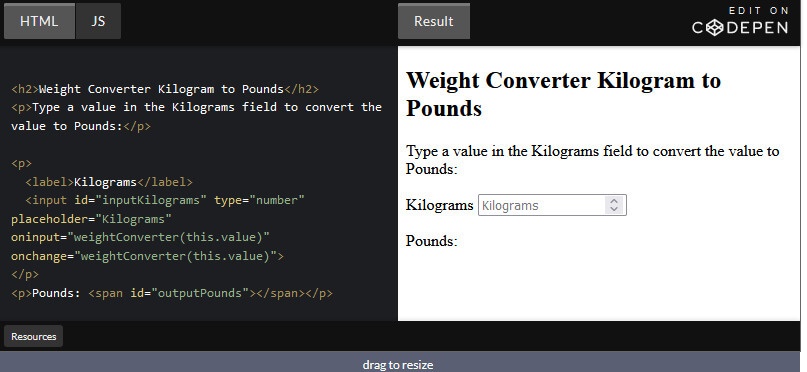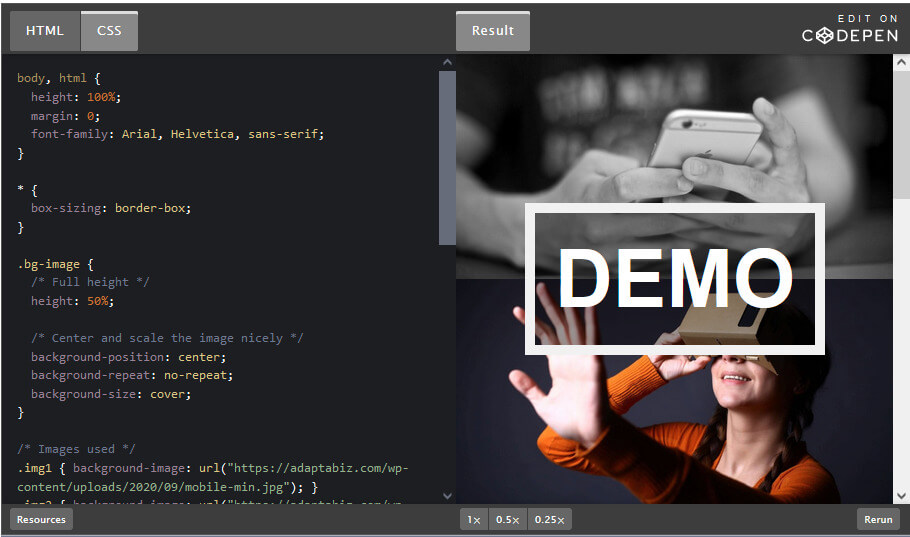
A Node.js app is run in a single process, without creating a new thread for every request. Node.js provides a set of asynchronous I/O primitives in its standard library that prevent JavaScript code from blocking and generally, libraries in Node.js are written using non-blocking paradigms, making blocking behavior the exception rather than the norm. It provides a rich library of various JavaScript modules which simplifies the development of web applications using Node.js to a great extent.
How Node.js handles a file request
- Sends the task to the computer’s file system.
- Ready to handle the next request.
- When the file system has opened and read the file, the server returns the content to the client.
Node.js Files
- Node.js files have the extension “.js”
- Node.js files must be initiated on the server before having any effect
- Node.js files contain tasks that will be executed on certain events
- A typical event is someone trying to access a port on the server
Features of Node.js
Following are some of the important features that make Node.js the first choice of software architects
Extremely Fast:
Node.js is built on Google Chrome’s JavaScript run-time Engine (V8 virtual machine). Node.js has non-blocking thread execution by which the developer can execute the code simultaneously without waiting for the first level execution end. As the executions are performed under the stack method, this makes the Node.js extremely fast and proficient.
Asynchronous and Event-Driven:
Asynchronous means that the server can respond to multiple requests at a time. It won’t stop or block any API request and will respond to all when the response is ready to send accordingly. As Node.js has Asynchronous I/O therefore, it increases the performance and responsiveness of the application. Whether it is opening a file, or making a connection, every action on a computer is an event. Node.js is event-driven, as soon as Node starts its server, it simply initiates its variables, declares functions and then simply waits for the event to occur.
Single threaded and highly scalable:
Node.js operates on a single thread using an event looping mechanism, where the main thread put requests onto the event loop and process them, effectively to achieve a high level of concurrency without having to assign additional threads. Single threaded event looping mechanism makes Node.js highly scalable as compared to traditional servers which allocate a limited number of threads to handle requests.

Easy Logging:
Logging plays a crucial role in supporting the complete application life cycle. Whether it is creation, debugging, or planning new features, logs support all. By analyzing the data, you can glean insights, fix bugs quickly, detect problems as soon as they happen.
No Buffering:
Node.js applications never buffer any data. These applications simply output the data in chunks.
Some of the amazing Node.js frameworks:
Hapi.js
Hapi.js is a powerful Node.js web framework for building application program interfaces (APIs) and other software applications. The framework has a robust plugin system and numerous key features, including input validation, configuration-based functionality, implement caching, error handling, logging and more. Hapi.js is used for designing useful applications, such as Postmile, a collaborative list-making tool.


Socket.io
Socket.io is a fast and reliable full-stack framework for building realtime applications. It is designed for real-time bidirectional event-based communication.
It comes with support for auto-reconnection, disconnection detection, binary, multiplexing, and rooms. It has a simple and convenient API and works on every platform, browser or device(focusing equally on reliability and speed).
Express.js
Express is a minimal and flexible Node.js web application framework that provides a robust set of features for web and mobile applications. It provides a thin layer of fundamental web application features, without obscuring Node.js features. It has features like robust routing, super-high test coverage, HTTP helpers, content negotiation, and much more.


Meteor.js
One of the fundamentally most used Node.js frameworks is Meteor.js. Meteor is an open-source, model-view-controller (MVC) framework for building websites and web/mobile applications. The framework supports OS X, Windows, and Linux. It allows writing both client and server parts of an application in JavaScript. Meteor’s inbuilt set of pre-written, self-contained modules makes writing application codes. Moreover, its reactive programming model allows creating applications using lesser JavaScript code. Besides, Meteor is a powerful framework for building real-time applications.
Total.js
Total.js is a modern and modular NodeJS supporting the MVC architecture. Angular.js, Polymer, Backbone.js, Bootstrap and other client-side frameworks are fully compatible with this framework. It effectively improves the most important aspects of your project during its lifetime. It has super-fast development, extremely low maintenance costs, stability, incredible performance, and easy scaling. This framework was written in 2013 from scratch and the main idea of this framework is to be complex, stable and without dependencies.


Derby
Derby is a full-stack framework for writing modern web applications. This is a model-view-controller (MVC) JavaScript framework for both client-side and server-side. It is ideal for creating real-time mobile and web applications. Derby’s Racer, a real-time data synchronization engine for Node.js allows multi-site, real-time concurrency and data synchronization across clients and servers. By leveraging ShareJS, Racer optimizes conflict resolution algorithm and allows real-time editing within an application. Moreover, server rendering is one such feature of Derby that allows fast page loads, search engine support and HTML templates to render in the browser or on the server.
Koa.js
Koa was created by the same team that created Express.js and it is often referred to as the next-generation NodeJS framework. It’s intended to be a smaller, more expressive, and more robust foundation for developing web applications and APIs. It employs promises and async functions to rid apps of callback hell and simplify error handling. Koa is unique in the fact that it uses some really cool ECMAScript(ES6) methods that have not even landed in some browsers yet. It allows you to work without callbacks while providing you with an immense increase in error handling.
It doesn’t pack any bundle of middleware in the core. That makes server writing with Koa faster and enjoyable. KoaJS comes with more options for customization. It allows you to work with applications from scratch where developers can add those features only which they need.


Nest.js
Nest.js is a framework built with Node.js, It is used for building efficient, scalable Node.js server-side applications. Nest uses progressive JavaScript and is written with TypeScript. It combines elements of OOP (Object Oriented Programming), FP (Functional Programming), and FRP (Functional Reactive Programming). It’s an out-of-the-box application architecture packaged into a complete development kit for writing enterprise-level applications. Internally, it employs Express while providing compatibility with a wide range of other libraries.
Mean.js
Mean.js is a full-fledged JavaScript framework to build web applications using NoSQL database, MongoDB as well as Angular.js for the front-end and Express.js/Node.js for the backend (server). It aims to provide a simple and enjoyable starting point for writing cloud-native full-stack JavaScript applications, starting from the top to the bottom. It is another Node.js framework built on Express.


Sails.js
Sails.js is one of the most popular real-time frameworks around for building Node.js applications. This MVC framework has gained traction through the development of chat applications, dashboards, and multiplayer games. It is most famous for building data-driven APIs. It uses waterline for object-related mapping and DB solutions. This framework uses Express.js for handling HTTP requests and is built upon Node.js. It is ideal for creating browser-based applications as it is compatible with all the Grunt modules, including LESS, SASS, Stylus, CoffeeScript, Jade, Dust, and more. Sails.js supports any front-end approach, such as Angular, Backbone, iOS/ObjC, Android/Java.
Adonis.js
Adonis.js is another popular Node.js web framework that is simple and stable with an elegant syntax on top of it. Adonis.js is an MVC framework that runs on all major operating systems and provides a stable ecosystem to write stable and scalable server-side web applications from scratch. Adonis.js is modular in design, it consists of multiple service providers, the building blocks of Adonis.js applications. A consistent and expressive API allows for building full-stack web applications or micro API servers. It is designed to favor developer joy and there is a well-documented blog engine to learn the basics of Adonis.js.










